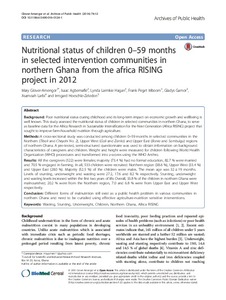| dc.contributor.author | Glover-Amengor, M. |
| dc.contributor.author | Agbemafle, I. |
| dc.contributor.author | Hagan, L.L. |
| dc.contributor.author | Mboom, F.P. |
| dc.contributor.author | Gamor, G. |
| dc.contributor.author | Larbi, Asamoah |
| dc.contributor.author | Hoeschle-Zeledon, Irmgard |
| dc.date.accessioned | 2019-12-04T10:57:33Z |
| dc.date.available | 2019-12-04T10:57:33Z |
| dc.date.issued | 2016-04-04 |
| dc.identifier.citation | Glover-Amengor, M., Agbemafle, I., Hagan, L.L., Mboom, F.P., Gamor, G., Larbi, A. and Hoeschle-Zeledon, I. (2016). Nutritional status of children 0–59 months in selected intervention communities in northern Ghana from the Africa RISING project in 2012. Archives of Public Health 74,12. |
| dc.identifier.issn | 2049-3258 |
| dc.identifier.uri | https://hdl.handle.net/20.500.12478/776 |
| dc.description.abstract | Background
Poor nutritional status during childhood and its long-term impact on economic growth and wellbeing is well known. This study assessed the nutritional status of children in selected communities in northern Ghana, to serve as baseline data for the Africa Research in Sustainable Intensification for the Next Generation (Africa RISING) project that sought to improve farm-household nutrition through agriculture.
Methods
A cross-sectional study was conducted among children 0–59 months in selected communities in the Northern (Tibali andCheyohi No. 2), Upper West (Goli and Zanko) and Upper East (Bonia and Sambulgu) regions of northern Ghana. A pre-tested, semi-structured questionnaire was used to obtain information on background characteristics of caregivers and children. Weight and height were measured for children following World Health Organization (WHO) procedures and transformed into z-scores using the WHO Anthro.
Results
All the caregivers (522) were females; majority (73.4 %) had no formal education, 82.7 % were married and 70.5 % engaged in farming. In all, 533 children were recruited: Northern region (38.6 %), Upper West (33.4 %) and Upper East (28.0 %). Majority (52.5 %) of the children were males. The mean age was 32 ± 19 months. Levels of stunting, underweight and wasting were 27.2, 17.6 and 8.2 % respectively. Stunting, underweight and wasting levels increased within the first two years of life. Overall, 33.8 % of the children in northern Ghana were malnourished; 20.2 % were from the Northern region, 7.0 and 6.8 % were from Upper East and Upper West respectively.
Conclusion
Different forms of malnutrition still exist as a public health problem in various communities in northern Ghana and need to be curtailed using effective agriculture-nutrition sensitive interventions. |
| dc.description.sponsorship | United States Agency for International Development |
| dc.language.iso | en |
| dc.subject | Livelihoods |
| dc.subject | Nutrition |
| dc.subject | Intensification |
| dc.title | Nutritional status of children 0-59 months in selected intervention communities in northern Ghana from the Africa RISING project in 2012 |
| dc.type | Journal Article |
| dc.description.version | Peer Review |
| cg.contributor.crp | Integrated Systems for the Humid Tropics |
| cg.contributor.affiliation | International Institute of Tropical Agriculture |
| cg.contributor.affiliation | Council for Scientific and Industrial Research, Ghana |
| cg.contributor.affiliation | University of Health and Allied Sciences, Ghana |
| cg.contributor.affiliation | University for Development Studies, Ghana |
| cg.coverage.region | Africa |
| cg.coverage.region | West Africa |
| cg.coverage.country | Ghana |
| cg.researchtheme | NUTRITION & HUMAN HEALTH |
| cg.isijournal | ISI Journal |
| cg.authorship.types | CGIAR and developing country institute |
| cg.authorship.types | CGIAR and advanced research institute |
| cg.iitasubject | Livelihoods |
| cg.iitasubject | Nutrition |
| cg.journal | Archives of Public Health |
| cg.howpublished | Formally Published |
| cg.accessibilitystatus | Open Access |
| local.dspaceid | 74770 |
| cg.targetaudience | Scientists |
| cg.identifier.doi | https://dx.doi.org/10.1186/s13690-016-0124-1 |

